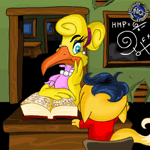Math of Neopia by nornlove |  |
|
NEOPIA CENTRAL - Have you ever seen one of those posters that says something like, "Math is everywhere"? Well, it's true! Today I'm going to help you figure out the math behind some parts of Neopia, trying to be as helpful and un-confusing as possible. If you’re already pretty good at math, you might want to skip forward to the * sign, that one’s more of a stumper unless you read through this. The first thing you're going to need to do is pull out a fairly good calculator (one with an n! or x! button) OR open up the calculator that comes with Windows (sorry Mac people!). Make sure it's in Scientific mode. Try not to panic at the sight of all those weird buttons, we're only going to use one of them, which happens to be the n! button. This button is called the factorial button. I'm sure that probably doesn't mean anything to you right now, but it will! To explain this, I'm going to use a little example here. Let's say that the Nimmo bookkeeper has 8 books to sell. How many different ways can he place them in his shop? I'm going to draw 8 lines to represent the 8 different places he can put a book. __ __ __ __ __ __ __ __ Now, pretend you're the shop keeper. How many different books could you choose from to put in the first space? 8! If you put one of the books in the first space, that means you have 7 to choose from in the second space, 6 in the third, and so on. So, if we multiply all those choices together, we'll get the number of different ways that he could arrange the books in his shop. 8x7x6x5x4x3x2x1=40320 *Whew*, that was a lot of work, wasn't it? Well, I'll show you an easier way to do that. Press the number 8 on your calculator, then press the n! button. You should get the exact same number. The n! button just multiplies whatever number you put in your calculator by all the whole numbers that come before it! Another way to write 8x7x6x5x4x3x2x1 is just as 8!. I hope you all got that, because I'm going to move on to some stuff that's a bit trickier (but fascinating for those of you that like to tempt the odds). If you think the next part looks a bit scarier, just skip a few paragraphs nearer to the end, I'll have some easier stuff there. Ever wondered what your chances are of winning The Neopian Lottery? Using the above handy dandy little key and a formula, I’ll show you how to calculate those chances. There are 30 different numbers to choose from in The Neopian Lottery, and each time you choose 6 of them. You could do this the hard way and write out every single possible combination, or, we can do this the math way. How did I know you’d choose the math way? Hehe. I’m going to show you a formula that might look a little complicated, but don’t worry, I’ll explain as we go along. The formula is: C= n!/(n-r)!x(r)! C is the number of combinations that are possible when you choose your numbers. N is the number of items you have to choose from. R is how many items (in this case, lottery numbers) that you’re choosing. That x means multiply, in case you’ve been taking Algebra lately and were confused by it. Oh yes, and in case you’re not used to seeing fractions this way, I used the / to mean divide. By the way, make sure to do the stuff in brackets first, if you haven’t learned so yet. So-ooo-ooo, if we plug in the information above for The Neopian Lottery, we get: C= 30!/(30-6)!x 6! Which we can further make into: C=30!/ 24!x6! Hopefully you’ve gotten a number that’s somewhere around 593775. That means that you have a 1 in 593775 chance of winning the big jackpot every time that you play The Neopian Lottery. By the way, you could also use the above formula, if you wanted to, to calculate your odds for Grarrl Keno. Oh yes, I also hope you didn’t decided to try and list every possible combination of number choices, teehee. We can also use that formula for another game, Neopoker! For example, let’s calculate the number of possible hands in Neopoker. Remember the formula, C= n!/(n-r)!x(r)! C= 52! (the number of cards in a deck)/47! (the number of cards in a deck minus the 5 in a hand) x 5! (the number of cards in a hand) For an answer, we get a whopping 2598960 different hands! Now, knowing that there are only 4 possible ways of getting a royal flush (one way for each suit), that means you only have a 4 in 2598960 chance of getting that elusive royal flush. We can simplify that to a 1 in 649740 chance by dividing both the four in the previous odds and 2598960 by 4. * Here’s where things get fun, or, if you really don’t like math, nasty. How many different ways are there of getting a full house in Neopoker? Well, first of all, we need to pick our three of a kind in the full house and put it in an equation. To get 3 of a kind, we’re going to choose 3 cards of the same number from 4 possible cards of that number. Using our handy dandy equation, which I am finally NOT going to repeat for you, that gives us 4 different ways to pick 3 of a kind from 4 cards of the same number. Now, once we have those 3, we need to pick out our pair. Same deal with the pair, except we have 6 different ways of picking the pair from 4 cards of the same number. So, that means so far we have: 4 choices x 6 choices But wait, we’re not done yet! Since there are 13 different card numbers (and letters) in a deck, that means we have 13 x 4 ways of choosing the 3 of a kind part of the full house. This is the twister, we only have 12 different card numbers or letters to choose the pair from. Why? Because if we chose again from all 13, that formula would include pairs made from the 3 of a kind number, which means we’d be cheating at Neopoker and would end up with a 5 of a kind hand in there somewhere. If we put this all together, this gives us: 4x13x6x12 , or 3744 different full house hands. Also, you’d have a 3744 in 2598960 chance of getting a full house, which is somewhat better than your chance of getting a royal flush. I hope you’re still with me here, because now I’m going to go back to the easier stuff. First of all, I’m going to explain why it stinks to get an 8 in Tyranu Evavu. 8 is right in the middle of the deck. There are 6 cards that are lower than an 8 in the deck, and 6 that are higher. 6/12 of the cards are above 8, 6/12 are below. If we reduce those fractions, ½ the cards are above, ½ are below. Those are bad odds compared to all of the other cards. No matter what you choose, you only have a ½, or 50% chance of being right. It gets worse! Say you had two 8’s in a row. Each time you got an 8, you’d have a ½ chance of guessing right. Your chance of getting it right stays the same, but your chances of guessing the right answer again if you get more than one 8 during the game decrease because it’s multiplied with the chance of guessing the right answer that you had the last time. ½ x ½ = ¼ chance of guessing right when you’ve had 2 8’s ½ x ½ x ½ = 1/8 chance of guessing right when you’ve had 3 8’s ½ x ½ x ½ x ½ = 1/16 chance of guessing right when you’ve had 4 8’s. Combined with all the other odds of guessing right, this explains why it’s so hard to get past 6 or 7 in Tyranu Evavu. Before I go, I’d also like to give away a little Bilge Dice hint. Let’s say it’s your second last roll, and you have the option of tying with the leader by keeping your 4, or going for the gold and rolling again. What are your chances of getting a 5 or a 6? Every time you roll that die (did you know that a single dice is called a die?), you have a 1/6 chance of getting a 5, and a 1/6 chance of getting a 6. Add those together, and you end up with a 2/6 chance of getting either. You also have a 1/6 chance of getting a 4 again. If you add that to your 2/6, that means you have a 3/6, or ½ chance of getting either the same number again or higher. Should you roll again? Well, that all depends on whether or not you think a ½ chance of winning is good enough or not, and I’m afraid I can’t help you with that, sorry. That wasn’t too bad, was it? Hopefully you all understand a bit better the odds behind many of the chance games out there, and maybe you’ve learned some math in the process, too.
| |
|




